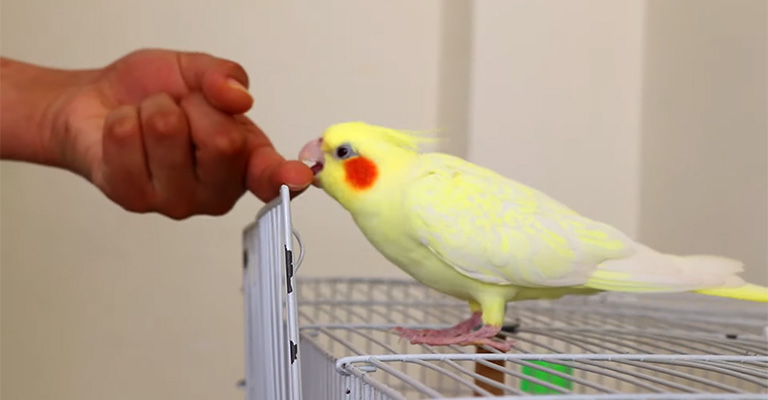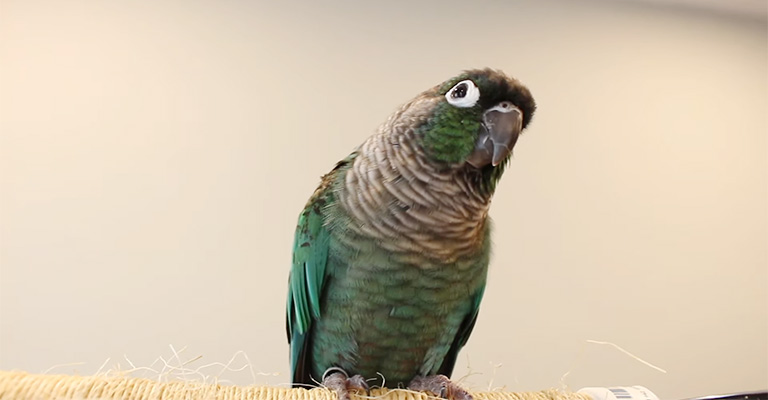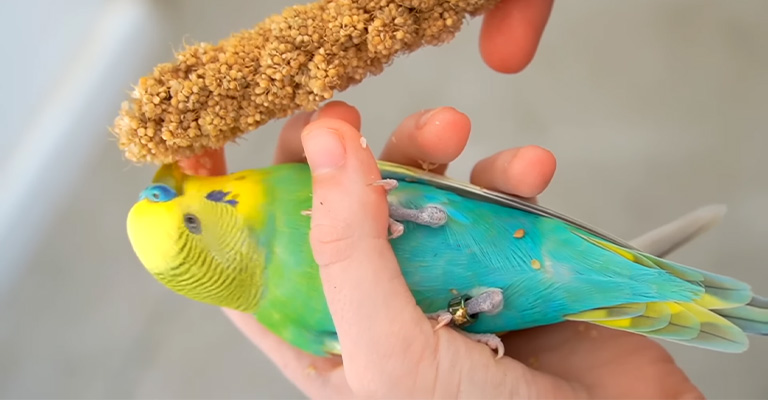Building trust with your pet bird is a journey that requires patience, understanding, and consistent effort.
Earning the trust of these sensitive and perceptive creatures involves creating a safe and positive environment, showing respect for their boundaries, and establishing a bond through shared experiences.
Trust is the foundation for a strong and enriching relationship with your feathered friend, enabling them to feel secure in your presence and fostering their willingness to engage with you.
So let’s know about how do I make my pet bird trust me.

How Do I Make My Pet Bird Trust Me?
Building trust with your pet bird is a gradual process that requires patience, consistency, and understanding. Here are nine tips to help you foster a strong bond of trust:
Respect Their Space
Begin by allowing your bird to acclimate to your presence. Spend time near the cage, talking softly and moving slowly to avoid startling them.
Offer Treats
Use treats to associate your presence with positive experiences. Offer favorite treats from your hand, allowing your bird to approach and take them at their own pace.
Soft and Calm Approach
Move smoothly and avoid sudden gestures that might frighten your bird. Speak in a gentle and reassuring tone to create a relaxed atmosphere.
Step-Up Training
Teach your bird the “step-up” command. Gently place your hand near them and encourage them to step onto your finger. Reward them with praise and treats for compliance.
Regular Interaction
Spend consistent, daily time with your bird. Engage in activities like talking, reading, or playing gentle games to build familiarity and trust.
Observation and Respect
Pay attention to your bird’s body language. If they show signs of discomfort or fear, respect their boundaries and give them space.
Routine and Predictability
Birds thrive on routines. Stick to a regular schedule for feeding, playtime, and interactions, helping your bird feel secure and confident.
Training Sessions
Incorporate short training sessions into your routine. Teaching commands like “step-up” or tricks builds communication and reinforces trust.
Physical Contact
As trust grows, gradually introduce gentle petting and touching. Focus on areas your bird enjoys, like their head or neck, and respect their comfort level.
Building trust takes time, especially for birds that might have had negative experiences in the past.
Be patient, understanding, and respectful of your bird’s boundaries. By consistently providing positive interactions, a calm environment, and opportunities for your bird to make choices, you’ll create a foundation of trust that will strengthen your bond over time.
Why Won’t My Bird Trust Me?

There are many possible reasons why your bird won’t trust you, depending on its species, personality, history, and environment.
Here are some behaviors that may indicate that your bird does not trust you:
Biting
Biting is a common way for birds to express their fear, anger, or discomfort. If your bird bites you hard or frequently, it means it does not trust you and wants you to leave it alone.
You should not react by yelling, hitting, or punishing your bird, as this will only make it more aggressive and distrustful. Instead, you should gently say “no” or “ouch” and put your bird back in its cage or on its perch.
Flying Away
Flying away is another way for birds to escape from something they do not like or trust. If your bird flies away from you whenever you approach it or try to handle it, it means it does not trust you and feels threatened by you.
You should not chase or grab your bird, as this will only scare it more and damage your relationship. Instead, you should use treats, toys, or praise to lure your bird back to you or its cage.
Screaming
Screaming is a loud and unpleasant way for birds to communicate their emotions. If your bird screams a lot or at certain times, it may mean it does not trust you and is unhappy, bored, lonely, or stressed.
You should not ignore or scold your bird for screaming, as this will only make it worse. Instead, you should try to find out the cause of your bird’s screaming and address it accordingly.
Feather Plucking
Feather plucking is a self-destructive behavior that birds do when they are depressed, anxious, or bored.
If your bird plucks its feathers excessively or baldly, it may mean it does not trust you and is suffering from physical or psychological problems.
You should not blame or punish your bird for feather plucking, as this will only add to its distress. Instead, you should take your bird to a veterinarian for a check-up and treatment.
Hiding
Hiding is a defensive behavior that birds do when they are scared or insecure. If your bird hides in its cage, under its wings, or behind objects, it may mean it does not trust you and feels unsafe in its environment.
You should not force your bird out of its hiding place, as this will only make it more fearful and distrustful.
Instead, you should provide your bird with a spacious and comfortable cage, a cozy nest or bed, and some toys and perches to make it feel more secure.
Panting
Panting is a sign of stress or overheating in birds. If your bird pants a lot or rapidly, it may mean it does not trust you and is nervous or uncomfortable around you.
You should not touch or handle your bird when it is panting, as this will only increase its stress and discomfort.
Instead, you should offer your bird some water and let it calm down in a cool and quiet place.
Fluffing Up
Fluffing up is a way for birds to adjust their body temperature or show their emotions. If your bird fluffs up its feathers occasionally or briefly, it may mean it is cold or relaxed.
However, if your bird fluffs up its feathers constantly or excessively, it may mean it does not trust you and is sick or unhappy.
You should not ignore or dismiss your bird’s fluffing-up behavior, as this may indicate a serious health issue. Instead, you should monitor your bird’s condition and take it to a veterinarian if needed.
Eye Pinning
Eye pinning is a way for birds to express their interest or excitement. If your bird pins its eyes (dilates and contracts its pupils) occasionally or moderately, it may mean it trusts you and is curious or playful around you.
However, if your bird pins its eyes frequently or intensely, it may mean it does not trust you and is angry or aggressive towards you.
You should not provoke or challenge your bird when it pins its eyes, as this may lead to a bite or an attack. Instead, you should respect your bird’s mood and give it some space.
Regurgitating
Regurgitating is a way for birds to show their affection or feeding behavior. If your bird regurgitates for you occasionally or gently, it may mean it trusts you and considers you as its mate or its chick.
However, if your bird regurgitates for you frequently or forcefully, it may mean it does not trust you and is trying to assert its dominance over you.
You should not encourage or accept your bird’s regurgitation behavior, as this may lead to health problems for both of you. Instead, you should discourage your bird from regurgitating by saying “no” or “stop” and moving away from it.
How Can I Make My Bird More Friendly?

Creating a friendly and trusting relationship with your bird requires patience, consistency, and positive reinforcement.
Here are some training methods to help make your bird more friendly:
Socialization
Spend regular, quality time near the cage, talking gently and maintaining a calm presence. Gradually offer treats or toys to associate your presence with positive experiences.
Positive Reinforcement
Reward desired behaviors with treats, praise, or gentle strokes. This encourages your bird to repeat these behaviors, fostering a positive connection with you.
Step-Up Command
Teach the “step-up” command by gently placing your finger near your bird’s belly and using the verbal cue. Reward them when they step onto your finger voluntarily.
Target Training
Use a target stick or a chopstick to teach your bird to touch a designated target. Gradually move the target to guide them onto your hand, rewarding their compliance.
Respect Personal Space
Allow your bird to approach you on their terms. Avoid forcing interactions or handling them when they’re not comfortable.
Interactive Play
Use toys and games to engage your bird. Play peek-a-boo, offer puzzle toys, or play with safe items like paper or cardboard, encouraging their curiosity.
Routine and Consistency
Birds thrive on routines. Maintain a consistent schedule for feeding, playtime, and training, helping them feel secure and know what to expect.
Voice Recognition
Use your bird’s name and talk to them regularly using a calm and soothing tone. This establishes a familiarity and connection with your voice.
Gentle Handling
Gradually introduce handling, starting with short periods of gentle petting and gradually extending the time as your bird becomes more comfortable.
Remember, each bird is unique and might respond differently to these training methods. Be patient, avoid sudden movements, and always respect their boundaries.
Creating a friendly bond takes time, but with dedication, your efforts will help nurture a strong and trusting relationship between you and your feathered friend.
FAQ
Building trust involves spending time near their cage, speaking softly, and offering treats from your hand. Move slowly and avoid sudden movements to prevent startling them.
Absolutely. Start by simply sitting near their cage, reading, or talking softly. Gradually offer treats, and as they become comfortable, you can extend your interactions by opening the cage door and letting them approach you.
Yes, regular interaction helps establish familiarity and reliability. Spend time with your bird daily, engaging in gentle interactions like talking, offering treats, and letting them explore your presence.
Offer treats from your hand, allowing the bird to associate your presence with positive experiences. Gradually, they’ll begin to approach you willingly to receive treats and interact.
Yes, signs of trust include your bird stepping onto your hand, grooming in your presence, or showing curiosity about your activities. They might also make gentle noises or relax when you’re nearby.
Conclusion
Cultivating trust between you and your pet bird is a delicate process that requires time and empathy.
By respecting their space, using positive reinforcement, and spending quality time together, you can establish a strong foundation of trust. Remember that each bird is unique, so be attuned to their individual preferences and comfort levels.
With patience, consistency, and genuine care, you can create a meaningful and lasting connection with your pet bird based on trust, mutual understanding, and companionship.